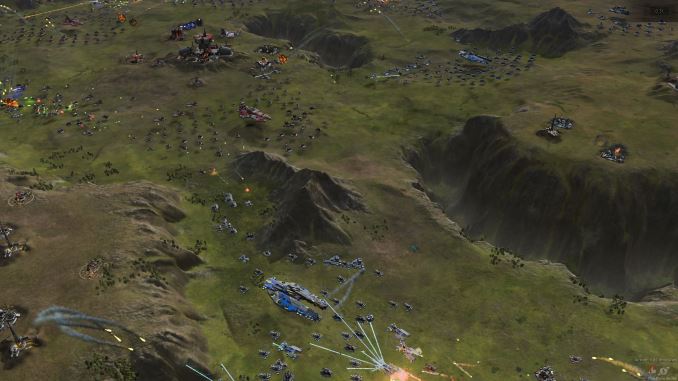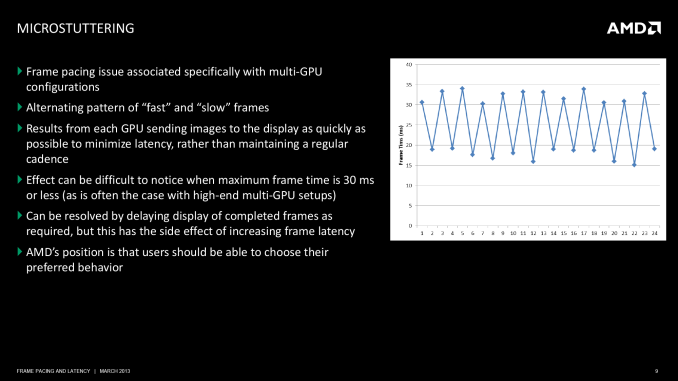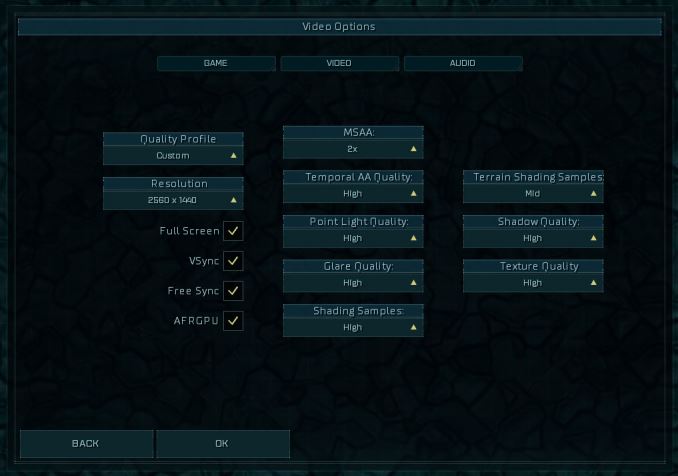GeForce + Radeon: Previewing DirectX 12 Multi-Adapter with Ashes of the Singularity
by Ryan Smith on October 26, 2015 10:00 AM ESTAshes of the Singularity: Unlinked Explicit Multi-Adapter with AFR
Based off of Oxide’s Nitrous engine, Ashes of the Singularity will be the first full game released using the engine. Oxide had previously used the engine as part of their Star Swarm technical demo, showcasing the benefits of vastly improved draw call throughput under Mantle and DirectX 12. As one might expect then, for their first retail game Oxide is developing a game around Nitrous’s DX12 capabilities, with an eye towards putting a large number of draw calls to good use and to develop something that might not have been as good looking under DirectX 11.
That resulting game is Ashes of the Singularity, a massive-scale real time strategy game. Ashes is a spiritual successor of sorts to 2007’s Supreme Commander, a game with a reputation for its technical ambition. Similar to Supreme Commander, Oxide is aiming high with Ashes, and while the current alpha is far from optimized, they have made it clear that even the final version of the game will push CPUs and GPUs hard. Between a complex game simulation (including ballistic and line of sight checks for individual units) and the rendering resources needed to draw all of those units and their weapons effects in detail over a large playing field, I’m expecting that the final version of Ashes will be the most demanding RTS we’ve seen in some number of years.
Because of its high resource requirements Ashes is also a good candidate for multi-GPU scaling, and for this reason Oxide is working on implementing DirectX 12 explicit multi-adapter support into the game. For Ashes, Oxide has opted to start by implementing support for unlinked mode, both because this is a building block for implementing linked mode later on and because from a tech demo point of view this allows Oxide to demonstrate unlinked mode’s most nifty feature: the ability to utilize multiple dissimilar (non-homogenous) GPUs within a single game. EMA with dissimilar GPUs has been shown off in bits and pieces at developer events like Microsoft’s BUILD, but this is the first time an in-game demo has been made available outside of those conferences.
In order to demonstrate EMA and explicit synchronization in action, Oxide has started things off by using a basic alternate frame rendering implementation for the game. As we briefly mentioned in our technical overview of DX12 explicit multi-adapter, EMA puts developers in full control of the rendering process, which for Oxide meant implementing AFR from scratch. This includes assigning frames to each GPU, handling frame buffer transfers from the secondary GPU to the primary GPU, and most importantly of all controlling frame pacing, which is typically the hardest part of AFR to get right.
Because Oxide is using a DX12 EMA AFR implementation here, this gives Ashes quite a bit of flexibility as far as GPU compatibility goes. From a performance standpoint the basic limitations of AFR are still in place – due to the fact that each GPU is tasked with rendering a whole frame, all utilized GPUs need to be close in performance for best results – otherwise Oxide is able to support a wide variety of GPUs with one generic implementation. This includes not only AMD/AMD and NVIDIA/NVIDIA pairings, but GPU pairings that wouldn’t typically work for Crossfire and SLI (e.g. GTX Titan X + GTX 980 Ti). But most importantly of course, this allows Ashes to support using an AMD video card and an NVIDIA video card together as well. In fact beyond the aforementioned performance limitations, Ashes’ AFR mode should work on any two DX12 compliant GPUs.
From a technical standpoint, Oxide tells us that they’ve had a bit of a learning curve in getting EMA working for Ashes – particularly since they’re the first – but that they’re happy with the results. Obviously the fact that this even works is itself a major accomplishment, and in our experience frame pacing with v-sync disabled and tearing enabled feels smooth on the latest generation of high-end cards. Otherwise Oxide is still experimenting with the limits of the hardware and the API; they’ve told us that so far they’ve found that there’s plenty of bandwidth over PCIe for shared textures, and meanwhile they’re incurring a roughly 2ms penalty in transferring data via GPUs.
With that said and to be very clear here, the game itself is still in its alpha state, and the multi-adapter support is not even at alpha (ed: nor is it in the public release at this time). So Ashes’ explicit multi-adapter support is a true tech demo, intended to first and foremost show off the capabilities of EMA rather than what performance will be like in the retail game. As it stands the AFR-enabled build of Ashes occasionally crashes at load time for no obvious reason when AFR is enabled. Furthermore there are stability/corruption issues with newer AMD and NVIDIA drivers, which has required us to use slightly older drivers that have been validated to work. Overall while AMD and NVIDIA have their DirectX 12 drivers up and running, as has been the case with past API launches it’s going to take some time for the two GPU firms to lock down every new feature of the API and driver model and to fully knock out all of their driver bugs.
Finally, Oxide tells us that going forward they will be developing support for additional EMA modes in Ashes. As the current unlinked EMA implementation is stabilized, the next thing on their list will be to add support for linked EMA for better performance on similar GPUs. Oxide is still exploring linked EMA, but somewhat surprisingly they tell us that unlinked EMA already unlocks much of the performance of their AFR implementation. A linked EMA implementation in turn may only improve multi-GPU scaling by a further 5-10%. Beyond that, they will also be looking into alternative implementations of multi-GPU rendering (e.g. work sharing of individual frames), though that is farther off and will likely hinge on other factors such as hardware capabilities and the state of DX12 drivers from each vendor.
The Test
For our look at Ashes’ multi-adapter performance, we’re using Windows 10 with the latest updates on our GPU testbed. This provides plenty of CPU power for the game, and we’ve selected sufficiently high settings to ensure that we’re GPU-bound at all times.
For GPUs we’re using NVIDIA’s GeForce GTX Titan X and GTX 980 Ti, along with AMD’s Radeon R9 Fury X and R9 Fury for the bulk of our testing. As roughly comparable cards in price and performance, the GTX 980 Ti and R9 Fury X are our core comparison cards, with the additional GTX and Fury cards to back them up. Meanwhile we’ve also done a limited amount of testing with the GeForce GTX 680 and Radeon HD 7970 to showcase how well Ashes’ multi-adapter support works on older cards.
Finally, on the driver side of matters we’re using the most recent drivers from AMD that work correctly in multi-adapter mode with this build of Ashes. For AMD that’s Catalyst 15.8 and for NVIDIA that’s release 355.98. We’ve also thrown in single-GPU results with the latest drivers (15.0 and 358.50 respectively) to quickly showcase where single-GPU performance stands with these newest drivers.
| CPU: | Intel Core i7-4960X @ 4.2GHz |
| Motherboard: | ASRock Fatal1ty X79 Professional |
| Power Supply: | Corsair AX1200i |
| Hard Disk: | Samsung SSD 840 EVO (750GB) |
| Memory: | G.Skill RipjawZ DDR3-1866 4 x 8GB (9-10-9-26) |
| Case: | NZXT Phantom 630 Windowed Edition |
| Monitor: | Asus PQ321 |
| Video Cards: | AMD Radeon R9 Fury X ASUS STRIX R9 Fury AMD Radeon HD 7970 NVIDIA GeForce GTX Titan X NVIDIA GeForce GTX 980 Ti NVIDIA GeForce GTX 680 |
| Video Drivers: | NVIDIA Release 355.98 NVIDIA Release 358.50 AMD Catalyst 15.8 Beta AMD Catalyst 15.10 Beta |
| OS: | Windows 10 Pro |













180 Comments
View All Comments
Scootiep7 - Thursday, October 29, 2015 - link
Actually, shouldn't that be switched? Brown would be the additive tertiary color wheel result, and yellow would be the subtractive tertiary color wheel result last I checked.xenol - Monday, October 26, 2015 - link
Now we can finally put this AMD vs. NVIDIA war to rest. Get both cards to get exclusive technologies, then when the game supports it, get the best horsepower of both.Tunnah - Monday, October 26, 2015 - link
We need to see the SLI/Xfire numbers first. It's all kinda pointless if 2 980Tis trounce em allsilverblue - Monday, October 26, 2015 - link
I doubt two 980 TIs would make much of a difference over a 980 TI and a Titan X.Refuge - Monday, October 26, 2015 - link
i think you are crazy if you are going to use any of these numbers for any argument, or buying decision.While interesting information to digest, it is merely that, this isn't Beta, this isn't even Alpha, this is is literally engineers saying "Hey guys check this shit out!"
I love what I'm seeing so far though, this is exciting, but the thought of EA, Bethesda, and Ubisoft being in control of so much does scare me...
EA = Pure evil
Bethesda = Tree's sticking through walls, Dragons having seizures in the air, and Chickens reporting your crimes to the local Police.
And Ubisoft? Well... I haven't given them much credit since the mid to late 90's...
naretla - Tuesday, October 27, 2015 - link
EA hasn't been the worst publisher for some time now. You could call them greedy, but at least they're relatively competent.Refuge - Tuesday, October 27, 2015 - link
Sim city, and Dragon Age Inquisition beg to differ.naretla - Tuesday, October 27, 2015 - link
Yeah, they went too far with SimCity, but it's been over two and a half years since then. Please elaborate re:DAI.Refuge - Tuesday, October 27, 2015 - link
I pre-ordered that game, against my better judgment I admit, and I wasn't able to play it for months because of fucking bugs. I won't pre-order anything from anyone until I see a change in the way these companies do business.I also agree that Simcity was a long time ago, but I've also not forgotten. I won't expect them to do better until I see them doing better.
it isn't just EA though, I won't pre-order Fallout 4 either for the very same reasons. Different publisher/Developer, but still the industry has left me jaded.
It is insulting to me when a publisher thinks that I'm stupid enough to be ok with paying full price for a game, only to get a beta build.
Its antics like that, that give me pause for celebration over all the new fine grained controls offered by DX12.
The potential is huge, the power and life extracted from the X 360, and PS3 were impressive towards the end of their life cycle, and I would love to see what they could do back then had they had the control they are being offered now. I also agree that the Dev's are the best ones to make the most of this technology.
But Dev's (unless Indie) are under the thumb of Publishers like EA, and their deadlines and budgets. It is this that gives me a lot of fear about the half baked disasters that could this way be headed.
SunnyNW - Tuesday, October 27, 2015 - link
I would think that the GPU vendors would help game developers with engineering resources. Probably not with this particular setup (EMA) but with say like Split Frame Rendering with two identical GPUs being utilized.